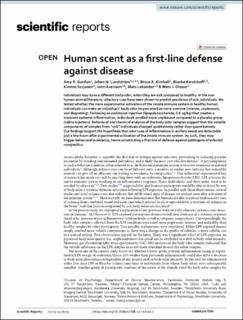| dc.contributor.author | Gordon, Amy R. | |
| dc.contributor.author | Lundström, Johan N. | |
| dc.contributor.author | Kimball, Bruce A. | |
| dc.contributor.author | Karshikoff, Bianka | |
| dc.contributor.author | Sorjonen, Kimmo | |
| dc.contributor.author | Axelsson, John | |
| dc.contributor.author | Lekander, Mats | |
| dc.contributor.author | Olsson, Mats J. | |
| dc.date.accessioned | 2024-02-22T11:38:28Z | |
| dc.date.available | 2024-02-22T11:38:28Z | |
| dc.date.created | 2023-11-09T12:44:29Z | |
| dc.date.issued | 2023 | |
| dc.identifier.citation | Gordon, A. R., Lundström, J. N., Kimball, B. A., Karshikoff, B., Sorjonen, K., Axelsson, J., ... & Olsson, M. J. (2023). Human scent as a first-line defense against disease. Scientific Reports, 13(1), 16709. | en_US |
| dc.identifier.issn | 2045-2322 | |
| dc.identifier.uri | https://hdl.handle.net/11250/3119303 | |
| dc.description.abstract | Individuals may have a different body odor, when they are sick compared to healthy. In the non-human animal literature, olfactory cues have been shown to predict avoidance of sick individuals. We tested whether the mere experimental activation of the innate immune system in healthy human individuals can make an individuals’ body odor be perceived as more aversive (intense, unpleasant, and disgusting). Following an endotoxin injection (lipopolysaccharide; 0.6 ng/kg) that creates a transient systemic inflammation, individuals smelled more unpleasant compared to a placebo group (saline injection). Behavioral and chemical analyses of the body odor samples suggest that the volatile components of samples from “sick” individuals changed qualitatively rather than quantitatively. Our findings support the hypothesis that odor cues of inflammation in axillary sweat are detectable just a few hours after experimental activation of the innate immune system. As such, they may trigger behavioral avoidance, hence constituting a first line of defense against pathogens of infected conspecifics. | en_US |
| dc.language.iso | eng | en_US |
| dc.publisher | Springer Nature | en_US |
| dc.rights | Navngivelse 4.0 Internasjonal | * |
| dc.rights.uri | http://creativecommons.org/licenses/by/4.0/deed.no | * |
| dc.title | Human scent as a first-line defense against disease | en_US |
| dc.type | Peer reviewed | en_US |
| dc.type | Journal article | en_US |
| dc.description.version | publishedVersion | en_US |
| dc.rights.holder | The authors | en_US |
| dc.subject.nsi | VDP::Medisinske Fag: 700 | en_US |
| dc.subject.nsi | VDP::Matematikk og Naturvitenskap: 400::Basale biofag: 470 | en_US |
| dc.source.volume | 13 | en_US |
| dc.source.journal | Scientific Reports | en_US |
| dc.source.issue | 1 | en_US |
| dc.identifier.doi | 10.1038/s41598-023-43145-3 | |
| dc.identifier.cristin | 2194540 | |
| cristin.ispublished | true | |
| cristin.fulltext | original | |
| cristin.qualitycode | 1 | |

